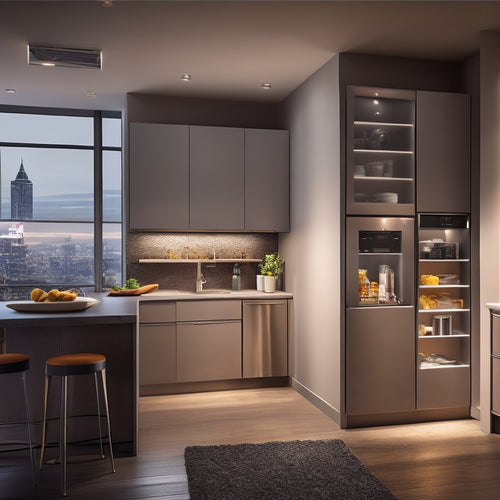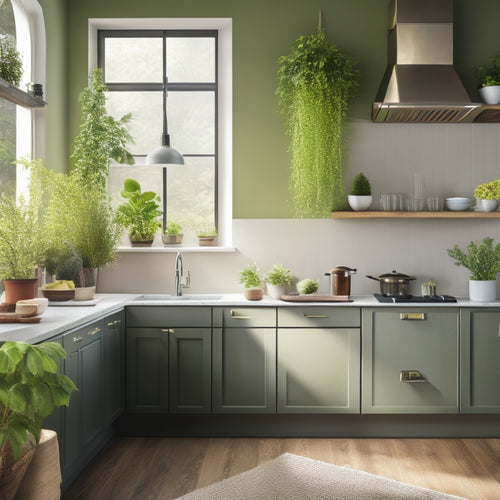
Kitchen Cabinet Purchase: A Comprehensive Guide
Share
Purchasing kitchen cabinets is a multifaceted process that requires careful consideration of various factors, including style, size, quality, budget, and installation logistics. With a vast array of styles, from modern to traditional, and varying sizes to fit unique spaces, cabinets must balance aesthetic appeal with functionality. Quality evaluation is essential, scrutinizing construction, materials, and craftsmanship to guarantee durability and efficiency. Budgeting and financing considerations, as well as material assessments, are also crucial. By exploring options, prioritizing needs, and making informed decisions, homeowners can create a harmonious kitchen space that reflects their unique taste and style. As you navigate the complexities of kitchen cabinet purchase, the possibilities unfold.
Key Takeaways
• Consider cabinet types, sizes, and styles to achieve the desired aesthetic appeal and functionality in your kitchen.
• Evaluate cabinet quality by scrutinizing construction, materials, and craftsmanship to ensure durability and functionality.
• Research and explore options through online resources, showroom displays, and expert consultations to find the best fit for your needs.
• Set a realistic budget range and compare prices across retailers and brands, factoring in installation costs and financing options.
• Inspect construction, finishes, and hardware to ensure durability and aesthetic appeal, and look for warranties or guarantees that meet quality standards.
Cabinet Types, Sizes, and Styles
Selecting the right kitchen cabinet type, size, and style is an important decision that sets the tone for the entire kitchen design. It not only impacts the aesthetic appeal but also affects the functionality and storage capacity of the space.
With various design trends emerging, homeowners can choose from a range of styles, from modern to traditional, to create a unique look. Cabinet organization is also a pivotal aspect, as it determines the efficiency of storage and workflow.
Consider the width, height, and depth of cabinets needed for ideal storage, and explore options such as wall, base, and tall cabinets to maximize space.
Evaluating Quality and Setting Budget
When evaluating kitchen cabinet quality, homeowners should prioritize durability and functionality by scrutinizing the construction, materials, and craftsmanship of potential purchases. A single compromise can jeopardize the entire kitchen's performance and longevity.
To ensure a well-crafted cabinet, examine the following:
-
Materials: Look for solid wood, high-quality plywood, and durable finishes that can endure daily wear and tear.
-
Craftsmanship: Inspect the cabinetry for precise joints, smooth drawer glides, and sturdy shelves that can bear heavy loads.
-
Construction: Verify that the cabinets are built with a sturdy frame, reinforced shelves, and secure door and drawer attachments.
Researching and Exploring Options
As you embark on the journey of finding the perfect kitchen cabinets, immerse yourself in a world of online resources, showroom displays, and expert consultations to uncover the ideal blend of form and function for your culinary space. Begin by conducting online research, exploring websites and virtual tours to get a sense of the various styles and options available.
| Research Method | Benefits | Resources |
|---|---|---|
| Online Research | Convenience, time-saving | Cabinets.com, RTA Kitchen Cabinets Online |
| Virtual Tours | Visual exploration, immersive experience | National Kitchen & Bath Association |
| In-Store Visits | Tactile experience, expert consultations | Home improvement centers, cabinet showrooms |
Next, plan in-store visits to inspect stock cabinetry and explore custom work examples. This all-encompassing approach will empower you to make an informed decision that meets your unique needs and preferences.
Budgeting and Financing Considerations
Within the context of kitchen cabinet purchasing, budgeting and financing considerations play an important role in determining the scope and feasibility of your project, requiring careful planning and strategic decision-making to assure a successful outcome. A thorough cost analysis is essential to secure that your cabinet selection aligns with your budget constraints.
To facilitate this process, consider the following key factors:
-
Set a realistic budget range for your kitchen cabinet purchase, comparing prices across different retailers and brands.
-
Explore financing options, if needed, and factor in installation costs and any additional services.
-
Prioritize payment options, such as cash, credit, or financing plans, to assure a smooth and stress-free transaction.
Assessing Quality and Materials
Evaluating the quality and materials of kitchen cabinets is an essential step in guaranteeing that your investment lasts for years to come. It begins with a close inspection of the construction, finishes, and hardware that define a cabinet's durability and aesthetic appeal.
Aesthetically, consider the wood type, grain pattern, and stain or paint finish. Look for solid wood or plywood construction, and inspect the drawers and shelves for sturdiness. Hardware options, such as soft-close hinges and ball-bearing drawer glides, can greatly impact the functionality and longevity of your cabinets.
Additionally, check for warranties or guarantees that provide assurance of the manufacturer's commitment to quality. By scrutinizing these details, you can guarantee that your kitchen cabinets meet your standards for both form and function.
Measuring and Planning for Installation
With a clear understanding of the quality and materials of your ideal kitchen cabinets, the next step is to accurately measure your kitchen space to guarantee a seamless installation process that brings your design vision to life.
To ensure the best possible space utilization, consider the following key measurements:
-
Record the room's dimensions, including the length, width, and any obstructions such as plumbing fixtures or electrical outlets.
-
Measure the door and window openings, taking note of their location and size to ensure proper cabinet placement.
-
Note the location of any appliances, including their dimensions and clearance requirements, to plan for a functional design layout.
Coordinating Delivery and Logistics
As the installation timeline nears, a meticulously orchestrated delivery and logistics plan is essential to guarantee a seamless shift from cabinet purchase to kitchen transformation.
To secure a hassle-free experience, schedule delivery of your cabinets well in advance, allowing for sufficient time to prepare the space. Verify the transportation details, including the delivery window and any specific requirements, such as a liftgate or inside delivery.
Once the cabinets arrive, allocate a designated area for storage and staging, ensuring easy access for the installation team.
Frequently Asked Questions
Can I Mix and Match Different Cabinet Styles and Brands?
When mixing and matching cabinet styles and brands, guarantee cabinet compatibility by considering design cohesion and brand cohesion to create a visually appealing space, while also prioritizing functional harmony in your kitchen.
How Do I Ensure a Seamless Finish Between Cabinets and Countertops?
To guarantee a seamless finish between cabinets and countertops, consider matching cabinet hardware with countertop materials and edge profiles, and coordinate colors to create a harmonious visual flow, resulting in a cohesive kitchen design.
What Is the Ideal Cabinet Layout for a Galley Kitchen?
In a galley kitchen, a harmonious cabinet layout harmonizes horizontal lines, cleverly incorporating lighting options, storage solutions, and deliberate material choices, while thoughtful hardware selection creates a visually appealing, functional space that exudes control and sophistication.
Are Soft-Close Doors and Drawers Worth the Extra Cost?
Soft-close doors and drawers are worth the extra cost, as they provide a luxurious feel, enhance drawer organization, and reduce wear and tear on cabinets, while also ensuring smooth and quiet operation, making installation a breeze.
Can I Repurpose Old Cabinets or Is It Better to Replace Them?
"Just as a master chef revives a vintage recipe, consider refinishing or upcycling old cabinets to breathe new life into their classic charm, but weigh the cost and effort against replacing them with modern, sleek designs that exude sophistication."
Related Posts
-

Revolutionize Your Kitchen With Smart Storage Solutions
You're about to reveal the secret to a kitchen that's both stunning and super functional. By incorporating smart stor...
-

3 Essential Steps to a Clutter-Free Kitchen
You'll reach a clutter-free kitchen by following three essential steps. First, purge and declutter by gathering items...

